
|
Now it is bright as 6.9 mag (July 1, Marco Goiato). It will be fading gradually after this. It is observable in excellent condition in the Southern Hemisphere. In the Northern Hemisphere, it locates low in the south.
Date(TT) R.A. (2000) Decl. Delta r Elong. m1 Best Time(A, h)
July 2 16 56.48 -48 4.4 0.742 1.688 146 6.6 22:06 ( 0, 77)
July 9 15 44.66 -43 36.5 0.898 1.751 132 7.2 20:30 ( 0, 82)
|

|
Now it is 11.6 mag (June 9, Marco Goiato). It keeps 11-12 mag until September. In the Northern Hemisphere, it will be getting lower gradually after this. In the Southern Hemisphere, it keeps observable in good condition for a long time.
Date(TT) R.A. (2000) Decl. Delta r Elong. m1 Best Time(A, h)
July 2 12 37.63 0 59.4 1.238 1.574 87 11.4 18:29 (166, 53)
July 9 12 50.73 -1 33.7 1.272 1.562 85 11.4 18:32 (157, 55)
|

|
Now it is 11.3 mag (June 10, Hiroshi Abe). It keeps 11 mag until summer. In the Northern Hemisphere, it will be unobservable soon. It locates somewhat low in the Southern Hemisphere, but it keeps observable until August.
Date(TT) R.A. (2000) Decl. Delta r Elong. m1 Best Time(A, h)
July 2 9 38.34 15 21.7 2.216 1.603 41 11.7 18:29 (125, 19)
July 9 9 58.00 13 48.8 2.238 1.596 39 11.7 18:32 (122, 18)
|

|
Now it is 11.5 mag (June 22, Thomas Lehmann). It will be fading slowly after this. In the Northern Hemisphere, it will be getting lower gradually and will be unobservable in August. It is observable in the evening sky also in the Southern Hemisphere until August.
Date(TT) R.A. (2000) Decl. Delta r Elong. m1 Best Time(A, h)
July 2 11 18.28 23 48.6 3.475 3.130 62 11.8 18:29 (151, 25)
July 9 11 23.15 21 39.7 3.616 3.185 57 11.9 18:32 (144, 25)
|

|
It will brighten up to 11 mag from summer to autumn. However, it was faint as 18.2 mag in February (Feb. 17, Alexander Baransky), fainter than this ephemeris by 2 mag. Now it is appearing in the morning sky, but it keeps low for some time.
Date(TT) R.A. (2000) Decl. Delta r Elong. m1 Best Time(A, h)
July 2 4 21.38 25 56.5 2.213 1.464 32 12.0 5:38 (232, 6)
July 9 4 46.96 25 58.2 2.170 1.437 33 11.9 5:37 (232, 7)
|

|
Now it is 12.7 mag (June 27, Juan Jose Gonzalez). It will be fading gradually after August. In the Northern Hemisphere, it keeps observable until early November. It becomes observable in the evening sky from July to September also in the Southern Hemisphere.
Date(TT) R.A. (2000) Decl. Delta r Elong. m1 Best Time(A, h)
July 2 15 20.53 54 59.8 2.727 2.921 90 12.7 20:36 (180, 0)
July 9 15 14.40 51 17.5 2.777 2.951 89 12.8 20:03 (180, 4)
|

|
It brightened up to 14 mag in minor outburst in early June. But it is faint as 16.1 mag now (July 1, Jean-Francois Soulier). It is observable in excellent condition in the Southern Hemisphere.
Date(TT) R.A. (2000) Decl. Delta r Elong. m1 Best Time(A, h)
July 2 19 41.52 -25 39.7 4.930 5.924 166 13.3 1:02 (180, 81)
July 9 19 38.01 -25 43.3 4.911 5.922 173 13.2 0:31 (180, 81)
|
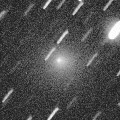
|
It brightened up to 10-11 mag in May. Now it is fading rapidly. But it is bright as 12.2 mag still now (June 26, Thomas Lehmann). It is observable in excellent conditione in the Northern Hemisphere. It is getting higher after this also in the Southern Hemisphere.
Date(TT) R.A. (2000) Decl. Delta r Elong. m1 Best Time(A, h)
July 2 16 51.41 44 33.1 1.165 1.763 107 13.5 22:04 (180, 11)
July 9 16 9.58 37 36.5 1.259 1.824 106 14.0 20:56 (180, 18)
|

|
Now it is 13.4 mag (May 22, Ken-ichi Kadota). It brightened up to 6 mag from autumn to winter. Now it is fading. In the Northern Hemisphere, it will be getting higher in the morning sky. It is not observable after this in the Southern Hemisphere.
Date(TT) R.A. (2000) Decl. Delta r Elong. m1 Best Time(A, h)
July 2 5 41.64 47 13.0 4.356 3.484 27 13.6 5:38 (225,-19)
July 9 5 46.49 47 29.2 4.401 3.563 30 13.7 5:37 (223,-16)
|

|
It brightened rapidly up to 13.2 mag (June 29, Hidetaka Sato). It will be observable at 12-13 mag until autumn.
Date(TT) R.A. (2000) Decl. Delta r Elong. m1 Best Time(A, h)
July 2 13 15.77 -13 10.7 1.684 2.142 102 13.9 18:33 (180, 68)
July 9 13 23.98 -12 59.1 1.740 2.122 97 13.7 18:32 (168, 68)
|

|
It became so bright as 8 mag in 2009. In the Northern Hemispehre, it will appear in the morning sky in July, then it will be observable at 11-12 mag from summer to autumn. In the Southern Hemisphere, it keeps extremely low for a long time until autumn.
Date(TT) R.A. (2000) Decl. Delta r Elong. m1 Best Time(A, h)
July 2 4 58.70 22 55.4 2.451 1.582 24 14.4 5:38 (240, 2)
July 9 5 22.13 23 11.1 2.403 1.551 25 13.8 5:37 (239, 2)
|
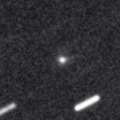
|
Now it is 13.5 mag (June 28, Chris Wyatt). It will be observable at 14 mag in good condition from spring to summer.
Date(TT) R.A. (2000) Decl. Delta r Elong. m1 Best Time(A, h)
July 2 21 16.02 -11 13.9 1.599 2.481 142 14.0 2:36 (180, 66)
July 9 21 14.90 -11 34.5 1.566 2.494 149 13.9 2:07 (180, 66)
|

|
It will brighten up to 13 mag in summer. But it keeps unobservable for a long time. It will appear in the morning sky in December, when the comet will be fainter than 15 mag.
Date(TT) R.A. (2000) Decl. Delta r Elong. m1 Best Time(A, h)
July 2 6 48.42 16 57.2 2.635 1.628 6 14.2 18:29 (101,-14)
July 9 7 10.53 16 12.5 2.588 1.581 6 14.1 5:37 (260,-14)
|

|
It is not observable now. It will be observable at 16.5 mag in September in the Northern Hemisphere, or in November in the Southern Hemisphere.
Date(TT) R.A. (2000) Decl. Delta r Elong. m1 Best Time(A, h)
July 2 6 44.56 18 38.5 2.996 1.984 4 14.2 5:38 (258,-16)
July 9 7 2.29 18 26.1 2.999 1.988 4 14.3 5:37 (257,-14)
|

|
Now it is 14.0 mag (June 10, Hiroshi Abe). Distant object, but it keeps observable at 14-15 mag for a long time from 2015 to 2016.
Date(TT) R.A. (2000) Decl. Delta r Elong. m1 Best Time(A, h)
July 2 0 40.28 2 29.5 4.782 4.890 90 14.3 5:38 (189, 52)
July 9 0 43.57 2 28.8 4.681 4.893 96 14.2 5:35 (180, 52)
|

|
It passed only 0.036 a.u. from the earth on Mar. 21-22, and brightened up to 3.9 mag (Mar. 21, Thomas Lehmann). It kept brightening even after the perihelion passage. However, it is fading rapidly now. It has already faded down to 17.1 mag (June 29, Hidetaka Sato). It keeps observable in excellent condition for a while after this both in the Northern Hemisphere and Southern Hemisphere.
Date(TT) R.A. (2000) Decl. Delta r Elong. m1 Best Time(A, h)
July 2 16 35.44 0 15.6 0.801 1.714 140 14.3 21:52 (180, 55)
July 9 16 37.02 -1 15.4 0.895 1.776 136 15.1 21:26 (180, 56)
|

|
Now it is 16.0 mag (May 14, Hidetaka Sato), brighter than originally predicted. It will brighten up to 14 mag in summer. In the Southern Hemisphere, it keeps observable until winter, but it locates somewhat low. In the Northern Hemisphere, it will be getting higher after this, and it will be observable in excellent condition.
Date(TT) R.A. (2000) Decl. Delta r Elong. m1 Best Time(A, h)
July 2 3 19.79 6 3.0 1.808 1.430 52 14.4 5:38 (235, 31)
July 9 3 39.29 8 27.0 1.789 1.434 53 14.5 5:37 (232, 30)
|
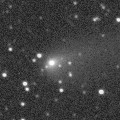
|
Now it is 13.9 mag (June 28, Chris Wyatt). It will be fading gradually after this. It is observable in excellent condition in the Southern Hemisphere. But it locates somewhat low in the Northern Hemisphere.
Date(TT) R.A. (2000) Decl. Delta r Elong. m1 Best Time(A, h)
July 2 15 18.19 -22 27.8 1.684 2.488 132 14.5 20:35 (180, 78)
July 9 15 19.72 -22 30.0 1.770 2.509 126 14.7 20:09 (180, 78)
|
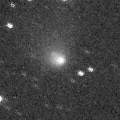
|
Now it is bright as 13.7 mag (June 28, Chris Wyatt). In the Northern Hemisphere, it will be getting lower gradually after this, and it will be unobservable in late July. In the Southern Hemisphere, it keeps observable in good condition until autumn. But it will be fading slowly after this.
Date(TT) R.A. (2000) Decl. Delta r Elong. m1 Best Time(A, h)
July 2 12 45.56 -21 28.5 1.988 2.361 98 14.8 18:29 (155, 75)
July 9 12 52.08 -22 27.4 2.074 2.368 93 14.9 18:32 (135, 73)
|
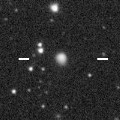
|
Now it is 14.6 mag (June 10, Artyom Novichonok). It is expected to brighten up to 7 mag in 2017 summer. In the Northern Hemisphere, it becomes low temporarily in summer, but it keeps observable in good condition until the highlight while the comet will be brightening. In the Southern Hemisphere, it is not observable until early 2017.
Date(TT) R.A. (2000) Decl. Delta r Elong. m1 Best Time(A, h)
July 2 8 24.28 54 52.8 5.136 4.365 36 15.0 18:29 (145,-19)
July 9 8 35.89 54 25.1 5.086 4.300 35 14.9 18:32 (143,-21)
|
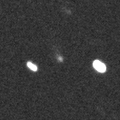
|
Now it is bright as 14.9 mag (May 4, Hidetaka Sato). It keeps 15 mag until autumn. In the Southern Hemisphere, it keeps observable for a long time. It will be unobservable after this in the Northern Hemisphere.
Date(TT) R.A. (2000) Decl. Delta r Elong. m1 Best Time(A, h)
July 2 6 44.52 -46 13.8 2.455 2.301 69 14.9 5:38 (313, 21)
July 9 7 8.85 -48 26.7 2.432 2.307 70 14.9 5:37 (315, 22)
|

|
New comet discovered from the STEREO spacecraft images in May. It brightened up to 8 mag due to the forward scattering. In the Southern Hemisphere, it is appearing in the evening sky, and it will be getting higher rapidly. It it not observable in the Northern Hemisphere.
Date(TT) R.A. (2000) Decl. Delta r Elong. m1 Best Time(A, h)
July 2 9 52.25 -4 40.6 1.172 0.994 53 15.3 18:29 (112, 35)
July 9 10 33.00 -7 52.8 1.246 1.105 57 15.9 18:32 (111, 39)
|
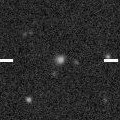
|
Now it is 16.6 mag (June 6, P. C. Sherrod, L. P. Sherrod). It is expected to brighten up to 7 mag in 2017 spring. But it locates somewhat low at the high light.
Date(TT) R.A. (2000) Decl. Delta r Elong. m1 Best Time(A, h)
July 2 11 15.03 -0 20.5 4.501 4.254 69 16.1 18:29 (135, 46)
July 9 11 18.59 -0 33.8 4.530 4.182 63 16.0 18:32 (128, 42)
|

|
Now it is 16.3 mag (June 26, Krisztian Sarneczky). It will brighten up to 14 mag in summer. It is observable in excellent condition in the Northern Hemispehre. In the Southern Hemisphere, it keeps locating low until August, but it will be observable in good condition after September.
Date(TT) R.A. (2000) Decl. Delta r Elong. m1 Best Time(A, h)
July 2 1 47.18 40 54.4 2.248 2.015 63 16.3 5:38 (197, 11)
July 9 1 38.95 42 3.1 2.075 1.987 70 16.1 5:37 (190, 12)
|
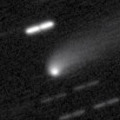
|
It brightened very rapidly in 2015 spring, and reached up to 13.8 mag (2015 May 11, Sandor Szabo). Now it is 15.7 mag (June 7, Yasukazu Ikari). It is observable in excellent condition in the Southern Hemisphere. But it locates somewhat low in the Northern Hemisphere.
Date(TT) R.A. (2000) Decl. Delta r Elong. m1 Best Time(A, h)
July 2 13 43.55 -25 10.7 3.905 4.391 112 16.1 19:01 (180, 80)
July 9 13 45.97 -24 57.8 4.028 4.420 106 16.2 18:36 (180, 80)
|
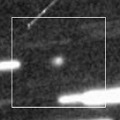
|
Now it is 16.8 mag (June 3, Yasukazu Ikari). It will be observable at 13 mag for a long time from 2017 to 2018. In 2016, it keeps observable at 16-17 mag in good condition until autumn.
Date(TT) R.A. (2000) Decl. Delta r Elong. m1 Best Time(A, h)
July 2 19 43.79 -11 3.6 5.281 6.253 161 16.4 1:04 (180, 66)
July 9 19 36.99 -10 49.6 5.215 6.210 167 16.3 0:30 (180, 66)
|

|
Now it is 16.4 mag (June 5, Yasukazu Ikari). It will be getting lower after this, and will be unobservable in August. It will brighten up to 14 mag in 2017. The perihelion distance increases from 2.4 a.u. to 2.9 a.u. in this apparition, and the comet will not brighten as before.
Date(TT) R.A. (2000) Decl. Delta r Elong. m1 Best Time(A, h)
July 2 11 39.37 10 2.4 3.824 3.625 71 16.4 18:29 (150, 40)
July 9 11 44.51 9 12.3 3.901 3.609 65 16.4 18:32 (142, 38)
|

|
Now it is bright as 17.3 mag (June 2, Yasukazu Ikari). It keeps 16 mag for a long time from 2016 to 2017. In 2016, it is observable in excellent condition in the Southern Hemisphere, but it locates extremely low in the Northern Hemispehre.
Date(TT) R.A. (2000) Decl. Delta r Elong. m1 Best Time(A, h)
July 2 12 23.32 -26 32.6 3.283 3.530 95 16.5 18:29 (126, 77)
July 9 12 29.91 -25 20.5 3.349 3.503 90 16.5 18:32 (117, 72)
|

|
First return of a new periodic comet which brightened up to 16.5 mag in 2008. The condition of this apparition is very good. It is expected to brighten up to 15.5 mag in autumn and will be observable in good condition.
Date(TT) R.A. (2000) Decl. Delta r Elong. m1 Best Time(A, h)
July 2 0 17.78 -19 44.3 2.080 2.520 103 16.7 5:37 (180, 75)
July 9 0 22.45 -19 11.3 1.984 2.501 108 16.5 5:14 (180, 74)
|
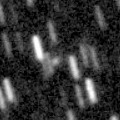
|
Now it is 17.0 mag (Feb. 7, iTelescope Observatory, Siding Spring). It keeps 16.5 mag for a long time in 2016, and it will be observable in excellent condition in the Southern Hemisphere. It is hardly observable in the Northern Hemisphere.
Date(TT) R.A. (2000) Decl. Delta r Elong. m1 Best Time(A, h)
July 2 3 44.84 -37 58.9 3.544 3.411 74 16.6 5:38 (290, 49)
July 9 3 44.06 -38 43.1 3.479 3.422 78 16.5 5:37 (289, 55)
|
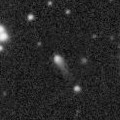
|
Now it is 16.5 mag (June 16, J. Camarasa). It keeps 16.5 mag from 2016 to 2017. It is observable in good condition in the Northern Hemisphere. In the Southern Hemisphere, it locates low in 2016, and it is not observable in 2017.
Date(TT) R.A. (2000) Decl. Delta r Elong. m1 Best Time(A, h)
July 2 16 47.27 35 23.2 5.841 6.343 115 16.7 22:03 (180, 20)
July 9 16 43.47 35 34.6 5.883 6.334 112 16.7 21:32 (180, 19)
|
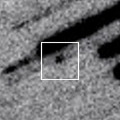
|
Appearing in the morning sky. It will be observable at 16 mag in good condition from autumn to winter. It locates somewhat low in the Southern Hemisphere.
Date(TT) R.A. (2000) Decl. Delta r Elong. m1 Best Time(A, h)
July 2 2 42.83 20 23.9 2.937 2.512 55 16.8 5:38 (217, 25)
July 9 2 54.69 21 34.5 2.867 2.510 59 16.8 5:37 (213, 26)
|
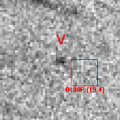
|
It is expected to brighten up to 16 mag and observable in good condition in autumn. However, it is so faint as 19.7 mag now (Apr. 16, A. Maury, J.-B. de Vanssay, J.-G. Bosch, J.-F. Soulier).
Date(TT) R.A. (2000) Decl. Delta r Elong. m1 Best Time(A, h)
July 2 23 16.50 -12 11.4 2.416 2.990 114 16.9 4:36 (180, 67)
July 9 23 18.52 -11 55.8 2.314 2.968 120 16.8 4:10 (180, 67)
|

|
Now it is 17.1 mag (June 14, Mt. Lemmon Survey). It will brighten up to 16.5 mag in summer and will be observable in good condition.
Date(TT) R.A. (2000) Decl. Delta r Elong. m1 Best Time(A, h)
July 2 17 51.07 -11 30.2 1.804 2.791 162 16.9 23:07 (180, 66)
July 9 17 45.95 -11 14.1 1.808 2.770 156 16.8 22:34 (180, 66)
|
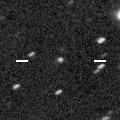
|
Now it is 17.0 mag (June 16, Catalina Sky Survey). It brightened rapidly, and became brighter than originally expected. It keeps 17 mag until 2017. It is observable in excellent condition in the Northern Hemisphere. It is not observable in the Southern Hemisphere.
Date(TT) R.A. (2000) Decl. Delta r Elong. m1 Best Time(A, h)
July 2 13 12.70 69 10.7 7.547 7.279 70 16.9 18:29 (180,-14)
July 9 13 7.91 68 0.3 7.583 7.278 68 16.9 18:32 (177,-13)
|

|
It brightened up to 3.7 mag and became a naked eye comet in mid January in 2015 (Jan. 13, Marek Biely). Now it is fading. It has already faded down to 15.6 mag (June 13, Catalina Sky Survey). In the Northern Hemisphere, it keeps observable for a long time until the comet fades out. It locates somewhat low in the Southern Hemisphere.
Date(TT) R.A. (2000) Decl. Delta r Elong. m1 Best Time(A, h)
July 2 17 37.31 25 19.5 5.375 6.066 128 16.9 22:53 (180, 30)
July 9 17 32.58 24 38.8 5.461 6.127 126 17.0 22:21 (180, 30)
|

|
It brightened up to 15 mag from late 2014 to early 2016. Now it is fading slowly. Now it is 16.6 mag (June 16, Catalina Sky Survey). In the Northern Hemisphere, it will be observable at 17 mag in autumn in good condition. It locates extremely low in the Southern Hemisphere.
Date(TT) R.A. (2000) Decl. Delta r Elong. m1 Best Time(A, h)
July 2 0 11.26 38 25.8 4.901 4.866 82 16.9 5:30 (180, 17)
July 9 0 5.95 39 35.2 4.824 4.896 88 16.9 4:58 (180, 15)
|
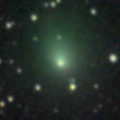
|
It brightened up to 10 mag in 2015 autumn. Now it is appearing in the morning sky, but it must be already fainter than 16 mag.
Date(TT) R.A. (2000) Decl. Delta r Elong. m1 Best Time(A, h)
July 2 2 51.59 12 10.8 3.159 2.729 56 17.0 5:38 (225, 31)
July 9 2 59.85 12 39.4 3.119 2.771 60 17.1 5:37 (220, 33)
|
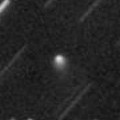
|
Now it is 16.7 mag (June 12, Mt. Lemmon Survey). It keeps brightening even after the perihelion passage. It keeps observable at 17 mag in good condition until autumn.
Date(TT) R.A. (2000) Decl. Delta r Elong. m1 Best Time(A, h)
July 2 14 34.49 7 53.5 6.171 6.610 111 17.1 19:51 (180, 47)
July 9 14 33.19 8 12.0 6.298 6.632 104 17.1 19:22 (180, 47)
|
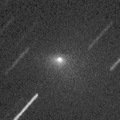
|
First return of an object discovered as an asteroid 2007 VA85 in 2007. It brightened very rapidly since mid February, and brightened up to 11.3 mag in spring (Mar. 5, Juan Jose Gonzalez). Now it is fading. It has already faded down to 16.1 mag (June 9, Hidetaka Sato). It keeps unobservable until September in the Southern Hemisphere.
Date(TT) R.A. (2000) Decl. Delta r Elong. m1 Best Time(A, h)
July 2 2 15.52 54 51.5 1.906 1.623 58 17.2 5:38 (196, -3)
July 9 1 58.18 57 2.5 1.832 1.685 65 17.6 5:37 (190, -3)
|

|
Now it is 17.5 mag (June 3, iTelescope SRO Observatory, Auberry). It keeps 17-18 mag until autumn. It keeps observable in excellent condition in the Northern Hemisphere. It will be getting lower gradually in the Southern Hemisphere.
Date(TT) R.A. (2000) Decl. Delta r Elong. m1 Best Time(A, h)
July 2 22 58.26 12 54.0 1.762 2.295 108 17.3 4:18 (180, 42)
July 9 22 45.46 16 59.3 1.670 2.292 114 17.2 3:38 (180, 38)
|

|
It brightened up to 13-14 mag from 2014 to 2015. Now it is fading. It has already faded down to 16.6 mag (June 5, Space Surveillance Telescope, Atom Site). It will be observable at 17 mag in 2016.
Date(TT) R.A. (2000) Decl. Delta r Elong. m1 Best Time(A, h)
July 2 23 26.56 -2 42.1 4.870 5.290 109 17.3 4:46 (180, 58)
July 9 23 26.96 -2 47.6 4.814 5.334 115 17.3 4:19 (180, 58)
|

|
Now it is 18.3 mag (June 8, B. Lutkenhoner). It will brighten up to 16 mag and will be observable in good condition in 2017. In 2016, it is observable in excellent condition in the Southern Hemisphere, but it keeps low in the Northern Hemisphere.
Date(TT) R.A. (2000) Decl. Delta r Elong. m1 Best Time(A, h)
July 2 19 11.26 -40 22.7 2.401 3.381 161 17.4 0:32 ( 0, 85)
July 9 19 5.00 -40 27.5 2.382 3.363 161 17.4 23:53 ( 0, 85)
|
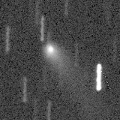
|
It was observed at 14-15 mag from 2014 to 2015. Now it is fading. In the Northern Hemisphere, it keeps observable in excellent condition until winter when the comet will be fainter than 18 mag. It is not observable in the Southern Hemisphere.
Date(TT) R.A. (2000) Decl. Delta r Elong. m1 Best Time(A, h)
July 2 3 28.17 64 45.1 6.143 5.580 52 17.4 5:38 (199,-16)
July 9 3 37.66 65 56.9 6.136 5.620 55 17.4 5:37 (197,-16)
|

|
It was observed as bright as 13-14 mag for a long time from 2011 to 2014. Now it is fading. It is observable in excellent condition in the Southern Hemisphere. It locates extremely low in the Northern Hemisphere. No observations have been reported since August, 2015.
Date(TT) R.A. (2000) Decl. Delta r Elong. m1 Best Time(A, h)
July 2 17 22.16 -37 23.7 8.717 9.662 157 17.5 22:38 ( 0, 88)
July 9 17 17.69 -37 28.7 8.796 9.696 150 17.5 22:06 ( 0, 87)
|
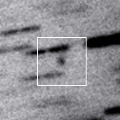
|
Now it is 17.7 mag (June 12, B. Lutkenhoner). It keeps observable at 17.5 mag in good condition from spring to autumn in the Southern Hemisphere. It is not observable in the Northern Hemisphere.
Date(TT) R.A. (2000) Decl. Delta r Elong. m1 Best Time(A, h)
July 2 17 47.48 -64 11.2 4.199 4.999 137 17.6 23:04 ( 0, 61)
July 9 17 42.80 -63 49.8 4.213 4.993 135 17.6 22:32 ( 0, 61)
|

|
It has not been observed in this apparition yet. It will brighten up to 17.5 mag in summer.
Date(TT) R.A. (2000) Decl. Delta r Elong. m1 Best Time(A, h)
July 2 20 39.71 -17 60.0 2.208 3.146 152 17.7 2:00 (180, 73)
July 9 20 36.17 -18 8.2 2.162 3.138 160 17.6 1:29 (180, 73)
|
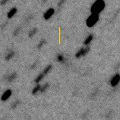
|
It brightened rapidly up to 15.1 mag in May (May 12, Yuji Ohshima). Now it is fading rapidly. It has already faded down to 17.3 mag (June 2, Yasukazu Ikari). It is observable in excellent condition in the Southern Hemisphere. It locates low in the Northern Hemisphere.
Date(TT) R.A. (2000) Decl. Delta r Elong. m1 Best Time(A, h)
July 2 14 38.69 -41 9.9 1.367 2.129 125 17.8 19:56 ( 0, 84)
July 9 14 41.06 -41 34.0 1.443 2.147 120 18.1 19:31 ( 0, 83)
|

|
Although it was bright as 17 mag at the discovery in 2006, it faded out before the perihelion passage in 2008, and it became lost. Now it is fainter than 19 mag (May 30, Jean-Francois Soulier).
Date(TT) R.A. (2000) Decl. Delta r Elong. m1 Best Time(A, h)
July 2 15 26.49 5 6.1 3.800 4.449 124 17.9 20:43 (180, 50)
July 9 15 25.20 4 32.5 3.873 4.443 118 17.9 20:14 (180, 51)
|

|
Very far object. Outburst occured on Feb. 20, 2015, and it brightened up to 15 mag. Now it is 17.8 mag (June 4, Space Surveillance Telescope, Atom Site). It is observable in excellent condition in the Southern Hemisphere. It locates somewhat low in the Northern Hemisphere.
Date(TT) R.A. (2000) Decl. Delta r Elong. m1 Best Time(A, h)
July 2 13 11.64 -22 8.8 8.898 9.202 104 17.9 18:29 (179, 77)
July 9 13 12.63 -21 58.1 9.010 9.205 97 17.9 18:32 (151, 75)
|
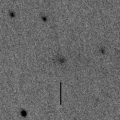
|
Now it is 17.6 mag (May 29, K. Hills). It was expected to brighten up to 14 mag from winter to summer. But it is much fainter actually. It will be observable in excellent condition in the Southern Hemisphere. It locates low in the Northern Hemisphere.
Date(TT) R.A. (2000) Decl. Delta r Elong. m1 Best Time(A, h)
July 2 16 4.91 -39 40.7 2.044 2.917 142 18.6 21:22 ( 0, 85)
July 9 16 4.99 -39 24.7 2.142 2.965 136 18.7 20:54 ( 0, 86)
|
|
![]()
 C/2014 W2 ( PanSTARRS )
C/2014 W2 ( PanSTARRS ) 29P/Schwassmann-Wachmann 1
29P/Schwassmann-Wachmann 1 C/2015 WZ ( PanSTARRS )
C/2015 WZ ( PanSTARRS ) C/2013 US10 ( Catalina )
C/2013 US10 ( Catalina ) 237P/LINEAR
237P/LINEAR 144P/Kushida
144P/Kushida 53P/Van Biesbroeck
53P/Van Biesbroeck C/2015 TQ209 ( LINEAR )
C/2015 TQ209 ( LINEAR ) 118P/Shoemaker-Levy 4
118P/Shoemaker-Levy 4 C/2011 KP36 ( Spacewatch )
C/2011 KP36 ( Spacewatch ) 252P/LINEAR
252P/LINEAR 146P/Shoemaker-LINEAR
146P/Shoemaker-LINEAR 116P/Wild 4
116P/Wild 4 77P/Longmore
77P/Longmore C/2015 V2 ( Johnson )
C/2015 V2 ( Johnson ) C/2015 T4 ( PanSTARRS )
C/2015 T4 ( PanSTARRS ) P/2016 J3 ( STEREO )
P/2016 J3 ( STEREO ) C/2015 ER61 ( PanSTARRS )
C/2015 ER61 ( PanSTARRS ) C/2016 A8 ( LINEAR )
C/2016 A8 ( LINEAR ) C/2014 W11 ( PanSTARRS )
C/2014 W11 ( PanSTARRS ) C/2015 O1 ( PanSTARRS )
C/2015 O1 ( PanSTARRS ) 65P/Gunn
65P/Gunn C/2016 B1 ( NEOWISE )
C/2016 B1 ( NEOWISE ) P/2008 J3 ( McNaught )
P/2008 J3 ( McNaught ) C/2015 B2 ( PanSTARRS )
C/2015 B2 ( PanSTARRS ) C/2014 OE4 ( PanSTARRS )
C/2014 OE4 ( PanSTARRS ) 56P/Slaughter-Burnham
56P/Slaughter-Burnham 188P/LINEAR-Mueller
188P/LINEAR-Mueller 219P/LINEAR
219P/LINEAR C/2014 R3 ( PanSTARRS )
C/2014 R3 ( PanSTARRS ) C/2014 Q2 ( Lovejoy )
C/2014 Q2 ( Lovejoy ) C/2014 A4 ( SONEAR )
C/2014 A4 ( SONEAR ) 22P/Kopff
22P/Kopff C/2015 LC2 ( PanSTARRS )
C/2015 LC2 ( PanSTARRS ) 333P/LINEAR
333P/LINEAR C/2016 K1 ( LINEAR )
C/2016 K1 ( LINEAR ) C/2012 F3 ( PanSTARRS )
C/2012 F3 ( PanSTARRS ) 47P/Ashbrook-Jackson
47P/Ashbrook-Jackson C/2014 N3 ( NEOWISE )
C/2014 N3 ( NEOWISE ) C/2010 S1 ( LINEAR )
C/2010 S1 ( LINEAR ) C/2015 H2 ( PanSTARRS )
C/2015 H2 ( PanSTARRS ) P/2008 T1 ( Boattini )
P/2008 T1 ( Boattini ) 100P/Hartley 1
100P/Hartley 1 P/2006 F1 ( Kowalski )
P/2006 F1 ( Kowalski ) C/2013 C2 ( Tenagra )
C/2013 C2 ( Tenagra ) C/2014 Y1 ( PanSTARRS )
C/2014 Y1 ( PanSTARRS )![]()







































